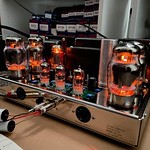wildiowa wrote:This may have been debated before...but would such upgrades only be viable if it were incorporated all through the electrical chain? Like using silver all the way from the wall outlet throughout the amp and right to the speakers themselves? Or do incremental and isolated uses change the sound enough to be viable or detectable? Like using a premium coffee but still running it through a funky dirty coffee maker? Not sure that's a good analogy, but hope you get the gist of my question...
Mpffffff.... RANT WARNING (and, there are Dynaco tube items involved):
A) Our power comes from the PMJ and we pay a very tiny, and decreasing, premium for it to be directed to/from the Iberdrola Wind Farm in Columbia County, PA. It is brought to us via Aluminum & Steel cable at ~138 KV after being inverted and stepped up at the farm. Overall, about 100 miles. At the sub-station about 1 mile from us, it is dropped to 13,200 V for transmission via overhead lines to a pole-mounted transformer about 100 yards from the house, and then via triplex to the SE cable (200A) at the house. 100% via aluminum conductors.
Thence to the electrical panel, via a 200A main breaker to a 20A distribution breaker via 12-gauge wire to the wall-plate - hospital-grade 20A device. That comes to One Inversion, Three transformations, Four switches, two breakers and two fuses in all - before it even sees the receptacle.
Please do not try to convince me that anything after all this is going to make one whit of difference - assuming that the line-cord is, at least, adequate for the load.
B) Friction connections: All friction connections are suspect, 100% of the time - yet they are sadly neglected for the most part. We are all familiar with tube sockets - how many of us are as aware of our RCA jacks and plugs? How many of use use Banana Jacks and plugs in "friction-only" mode? Often carrying many watts. Putting fancy cables onto a Banana Jack in friction-only mode is much like putting a 4" pipe on a 1/2" valve.
C) Clamped Connections: They also heat/cool/heat/cool/expand/contract/expand/contract. It really pays to clean and remake them every so often - more-so in a house full of cats, dogs and occasional grandchildren and grand-puppies.
D) Fact & Theory: the amount of current any given conductor can carry without losses is a function of surface-area, general conductivity, temperature, length and conductor purity. All of which can be calculated. There are some basic things - stranded by weight is a better conductor than solid-by-weight. Conductors, within broad limits cannot be too big, but can be too small. Most currents running around in audio components are far 'less' than the conductor limits they are running within. Keep in mind that the windings in that Audio Output Transformer are often as fine as 30 gauge, more typically around 22 gauge. And all your B+ and all your signal goes through that wire. So, the brute fact of the matter, and the physics, and that-which-can-(and may)-be-measured is a function of conductor material, conductor purity, surface area, temperature and length. Nothing Else. A rusty coat hanger will do just fine as speaker wire if the connections are sufficiently tight and the distance is sufficiently short. Physics. Whereas "Skin Effect" as formally described is not a factor at audio frequencies, the skin of whatever conductor in use does all the 'work' - and why it is that stranded wire is a better conductor than solid wire, all other things being equal.
We have five active stereo systems at home, and 1.5 at our summer house (we use a Dynaco SCA-80 into AR speakers for the CD Player sound). All of them use conventional cables, patch-cords and various other conductors but for the Main System that uses a set of Monster Cable speaker wires obtained at a garage sale, and monster-cable patch-cords (same source) for the phono input. Of all this, Dynaco is involved in three of them, of those three, two are committed to Dynaco. Of the two that are committed, one is also committed to tubes, the other involves them. If one wants to understand the difference, consider Ham and Eggs. The chicken is involved, the pig is committed. I would posit that I spend more time cleaning and tightening connections than rolling tubes by a pretty large margin. Y'all try it sometime on your main stereo - end-to-end. Please report the differences, if any. Note that this is, in some cases, a hood-up operation, especially as it relates to RCA jacks.




